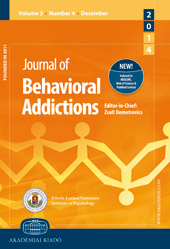Prevalence and co-occurrence of addictive behaviors among former alternative high school youth
Prevalence and co-occurrence of addictive behaviors among former alternative high school youth
Author(s): Steve Sussman, Thalida Em Arpawong, Ping Sun, Jennifer Tsai, Louise A Rohrbach, Donna Spruijt-MetzSubject(s): Psychology, School education, Behaviorism, Substance abuse and addiction
Published by: Akadémiai Kiadó
Keywords: multiple addictions; prevalence; co-occurrence; latent class analysis; addiction groups; convergent validity;
Summary/Abstract: Recent work has studied multiple addictions using a matrix measure, which taps multiple addictions through single responses for each type. Methods: The present study investigated use of a matrix measure approach among former alternative high school youth (average age = 19.8 years) at risk for addictions. Lifetime and last 30-day prevalence of one or more of 11 addictions reviewed in other work (Sussman, Lisha & Griffiths, 2011) was the primary focus (i.e., cigarettes, alcohol, other/hard drugs, eating, gambling, Internet, shopping, love, sex, exercise, and work). Also, the co-occurrence of two or more of these 11 addictive behaviors was investigated. Finally, the latent class structure of these addictions, and their associations with other measures, was examined. Results: We found that ever and last 30-day prevalence of one or more of these addictions was 79.2% and 61.5%, respectively. Ever and last 30-day co-occurrence of two or more of these addictions was 61.5% and 37.7%, respectively. Latent Class Analysis suggested two groups: a generally Non-addicted Group (67.2% of the sample) and a “Work Hard, Play Hard”-addicted Group that was particularly invested in addiction to love, sex, exercise, the Internet, and work. Supplementary analyses suggested that the single-response type self-reports may be measuring the addictions they intend to measure. Discussion and Conclusions: We suggest implications of these results for future studies and the development of prevention and treatment programs, though much more validation research is needed on the use of this type of measure.
Journal: Journal of Behavioral Addictions
- Issue Year: 3/2014
- Issue No: 1
- Page Range: 33-40
- Page Count: 8
- Language: English

